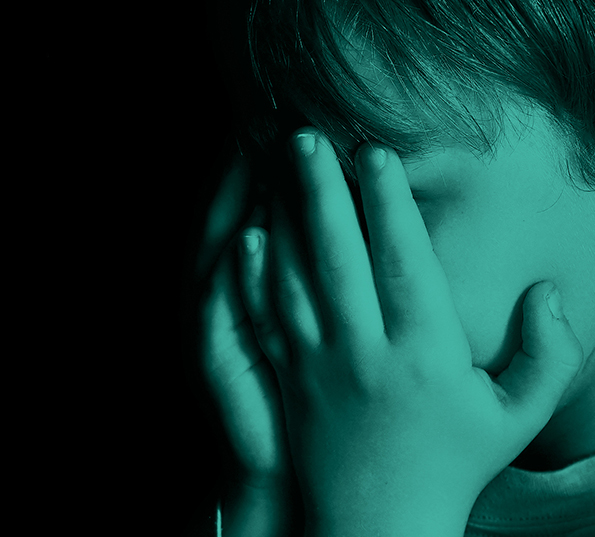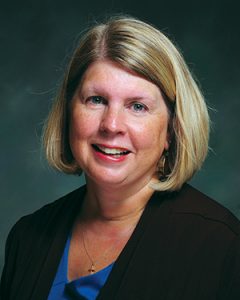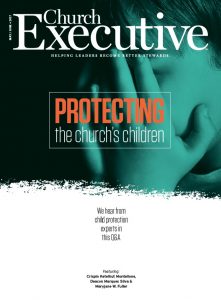
We hear from child protection experts in this Q&A
In the role of caring adults, we’re supposed to do all that we can to keep children from harm, and provide a safe place for all. Our panelists discuss the topics and challenges of protecting children within the church environment — and how to establish policies that mitigate these risks.

Associate Director
VIRTUS Program via
NCS Risk Services LLC
What type of risks does each church face?
Montelione: The problem is that we always have risk. There’s risk of physical harm and emotional harm. There’s risk of abuse, including sexual abuse, which can affect many different things. It can have long and far-reaching effects for the child and for your church. When we have risk and something bad happens, we have to repair that trust. We have to think about the future viability of our churches. Depending on the gravity of that situation, it can take years and decades to fix that, if it’s possible to fix it — because, sometimes it isn’t.
We really must perform specific safe environment procedures concurrently. It’s akin to having a fence surrounding a garden. If we have a beautiful garden that we’re trying to protect, and there’s one plank missing in that fence, that’s a known risk, and something is going to get through.
We always have obvious risks that we know about when we’re thinking about the

Director of the Office of Child
Protection and Safety
Catholic Diocese of Arlington
location. For example, if it’s poorly maintained as a facility, that’s a risk itself. However, another risk is if you have registered sex offenders in a faith community. That’s a risk to children.
There are also some lesser-known risks. One is a lack of access control and monitoring. There is also increased risk, automatically, within any church environment and any ministry because there’s always an assumption of trust and safety. That perspective brings its own risk.
The good news is that we can drastically reduce the risk to children in virtually any church environment as long as we’re vigilant and we have specific protocols.
What kind of questions must be considered when creating protocols for your church?
Fuller: Controlling access is a very important part of our Safe Environment Program training. When we talk about control access, we’re asking, Do we have locks on

Director of Human Resources
and Safe Environment
Catholic Diocese of Richmond
doors? Do we have protocols on keeping doors in parishes locked when children are present? Do we have applications for our ministry? This gives us a chance to sit down and to share what our policies and procedures are.
Face-to-face interviews for staff and volunteers are extremely important, as are background checks. This is important in any environment where children are involved. Code of conduct and knowledge of policies are just as important.
In terms of monitoring programs and procedures, we need to keep a close eye on the programs that involve our children or where children are present. Is there some kind of video security? Are you walking through buildings and making sure that doors that should be locked remain locked? What are the secluded areas?
“We really must perform specific safe environment procedures concurrently. It’s akin to having a fence surrounding a garden. If we have a beautiful garden that we’re trying to protect, and there’s one plank missing in that fence, that’s a known risk, and something is going to get through.
— Crispin Ketelhut Montelione
Montelione: There’s a distinction between the things that you do before people ever have an opportunity to volunteer or to work, and then there are also the things that you do to ensure the environment is safe once people have access.
What if your ministry programs are off-site? What types of risk are associated with this?
Fuller: For myself and the diocese I work with, off-site happens when we go to retreat centers or on field trips. It’s a huge challenge, because we really do lose control in many ways. We take a lot of care in trying to understand where our ministry is going. Is it a retreat center? Is it in someone’s home? Is it a hotel? We want to make sure that we follow our code of conduct and that everyone is well aware of these policies.
We also have to consider what to do if something involving boundary crossing or even possible abuse happens. Who do you tell? When do we involve civil authorities? When are we told as a church? I don’t think we can do enough to protect kids, especially as we leave our churches and go to different locations. Again, it always falls back to: What is our policy? and How have we trained our adults?
How do you deal with the risks associated with the internet?
Silva: The internet is considered an off-site location because there’s a lack of transparency. You can never see who’s looking in or who has the availability to our youth.
It becomes even easier access when we’re talking about anything with a data plan and can connect to the internet, such as smart phones, to tablets, to Apple watches. We also have various gaming devices like Playstation, Xbox, or even Fitbits. The challenge that we have is that we’re used to keeping strangers away from the kids by monitoring the environment around them. A couple of issues come up in regards to this.
One issue is that children have access to things such as pornography. The main consumer of pornography are teens between 12 and 17 — and usually they don’t go looking for it; it can find them.
Social media is another issue that’s very much out of control. The very nature of these applications and programs are interaction with the community through the internet, often times out of sight and hearing of adults.
A challenge of social media is not only safety, but the reputation of the individual. Kids don’t understand that when something is out on the internet, it’s not private and it’s there forever. Even if they delete it, they can’t take it back. It’s not just what they put up themselves, it’s what their friends and families put out there, as well.
I think we need a sober understanding — especially within our communities — of providing training for parents. I think the most vulnerable set of kids are the “it’s not my kids” population. Education, training and reinforcement need to start as early as possible.
Are there challenges within different age groups when it comes to addressing internet issues?
Fuller: Kids are far more savvy than adults in many ways when it comes to the internet and social media. The challenge is, we need to be just as savvy. We need to stay on top of it. It’s not enough to say, ‘Well, you know, I’m a different generation; let the millennials handle it.’ It’s just as much our responsibility. We have had some incidents within the state of Virginia where children have been abused when a perpetrator gained access via an app such as Kik. The parent didn’t understand or know what the app was all about. We, as caring adults, need to be as savvy as our kids on these topics.
How does ‘human predilection,’ or human bias, factor in to our ability to protect children?
Silva: We’re always combating the fact that we don’t want to suspect any inappropriate behavior from not only the people we love, but those who might be right next to us in our services or events. When an inappropriate action has taken place, there’s an attitude of disbelief.
This also happens to be part of the grooming process. The individual who’s a predator is always looking to groom and keep people close to them, so that when there is an accusation, there’s a part of the community that’s going to defend.
Overcoming disbelief is a challenge. Not only is there a disbelief about another person being capable of harming a child, but there’s a mentality present with parents who think that it couldn’t happen to their child, or in the parish. There’s no sign that predators wear; they’re able to blend in, and that’s what makes them so effective, unfortunately. We have to address myths and help individuals understand the truth about abusers and predators.
We also have to work on burnout and laziness. When adults start to relax too much, it can allow for loopholes that potential predators will identify to start the grooming process.
How might culture affect Safe Environment?
Montelione: It can affect it in two ways. You have a collective organizational culture as an entity, and there’s tradition within that entity that becomes culturally acceptable and establishes the “norm,” regardless of the actual behavior that’s occurring. Then, you also have the juxtaposition of the individual’s cultural identity. This could determine whether a particular behavior is appropriate or not, and is impacted by personal values, family, ethnic traditions, country of origin, etc.
The problem is that it can negatively affect Safe Environments. It can either provide more access to the youth or less access to the youth. Even if the person has good intentions, they might not realize what they’re doing. It can unwittingly condition that child to more easily accept behavior on behalf of someone who has bad intentions. We want to be really aware of that and our own actions.
What do you frequently hear when establishing protocols and training, particularly in a parish that has become lax?
Fuller: A lot of times people will say, ‘Well the person only volunteers two or three times a year, so we don’t need to worry about it.’ Or, ‘They’ve been a member of

this parish for 20 years,’ and ‘We’ve been doing this long enough, we don’t need to worry about it anymore.’ We have to remind people that we don’t know what we don’t know. We need to take care and do a background screening of all employees and volunteers, and make sure they attend training so they know the warnings signs and policies.
Folks are busy! Whether a parent, grandparent or youth volunteer attends a training, 9.9 times out of 10 they’re glad they took the time. There’s a realization by the end of the training that that there is so much to learn. You’ll always combat resistance to get people to attend a training; but in the end, the more we know, the more children we protect. VIRTUS provides continuing training via monthly online bulletins to keep the issues of child protection and child safety in the forefront. These updates have been positively received in our diocese.
Silva: We’re trying to create an environment for our kids to have the opportunity to come in contact with the living God. It’s important that our communities can trust the local church. When an incident happens, it’s doesn’t just hurt a particular denomination — it hurts all of us. Because we do have the best intentions for our kids, for their safety and for the adults.
Questions? Readers ask, experts answer
Should the church allow access to wifi?
Silva: The question I always ask churches is, Why are you allowing the wifi? What’s the point of it? Is it just for general access? The majority of the people coming in with their cell phones have data plans.
If there is wifi access at your church, then I’d always require a password that needs to be given for our particular events. The reality is, if something happens while they’re connected to your network, you — as a church — are going to bear some of the responsibility for it.
“Protecting the Church’s Children”
Our experts explain how location (including off-site ministry locations and the Internet), culture and human predilection can weaken the systems designed to protect youth in your church’s care — and what
you can do about it!Available now at www.churchexecutive.com/webinars
A lot of our churches do offer wifi access; but again, you have to have that password, and it’s used for particular events, at particular times, for a particular purpose. General wifi access isn’t usually offered.
How can a church provide sacramental and worship opportunities to a registered sex offender while ensuring there’s a Safe Environment for children?
Silva: Here in the diocese of Arlington, we write out contracts. From our perspective, that parishioner has a right to receive that sacramental assistance, as well as worship opportunities, but that doesn’t mean they get to choose it. We develop contracts that determine what service they go to, where they may sit, what they may do, and who they check in and out with. We sit down and have the pastor sign off on this. We have the registered sex offender sign off on it.
Then, we do checks once a year to see how the relationship is going. That way, we’re able to give them the freedom to receive the sacrament and the worship experience, while managing the risk involved.
You also have to recognize that sometimes, depending on the felony (here in Virginia, it’s a class 6 felony, which is child abuse), you can’t be within 150 feet of a school. Sometimes that means we have to move them from the parish so they can have sacramental outreach — but they aren’t violating their parole.
Montelione: Those are all good points for the predators we know of, but it’s important to recognize that you’re not always going to know who has good intentions, who has bad intentions, who’s a registered offender and who isn’t.
We want to be really careful when we look at the sex offender registry online. When we’re focused on a particular house, it opens up risk on all the other houses in the area, because we’re so fixated on one area. We really want to make sure everyone is held to the same standard. Where we know there’s a risk, we have other protocols that we follow. But apart from that, we want to hold everyone to the same standard.
— Reporting by Joyce Guzowski


